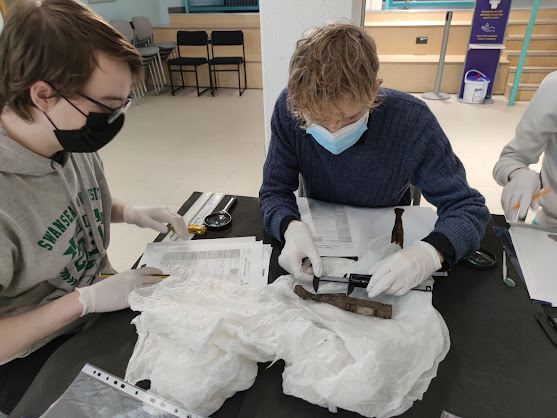Many readers of this blog will know that the Egypt Centre is a strong advocate of object-based learning (OBL). Several blog posts have previously highlighted handling sessions delivered to Swansea University students and other audiences. While the COVID-19 Pandemic meant that in-person handing sessions couldn’t take place, since October 2021 these have been able to resume again. This semester is particularly busy as the Egypt Centre works with colleagues in the Faculty of Humanities and Social Sciences at Swansea University. This short blog post will briefly highlight some of the exciting opportunities provided to Swansea University students this semester.
 |
| Fig. 1: Students examining a First Intermediate Period stela (EC148) |
Second-year Egyptology students have had weekly handling
sessions as part of a module led by Dr
Christian Knoblauch on Egyptian Art and Architecture (CLE220). So
far, they have had weeks on sculpture and relief, while the most recent session
looked at the art of the Old Kingdom. These handling sessions are directly
related to assessment, so the students are always very attentive. Students
spend approximately fifteen minutes examining an object before switching to
another one (fig. 1).
In total, they have the opportunity to examine five to six objects per session.
At the end, students are asked to stand next to the object they liked the most,
which is always a fun experiment!
 |
| Fig. 2: Students practising conditions reports |
For many years now, Egypt Centre staff have been directly involved in teaching an MA module (CL-M77) called Reaching the Public: Museums and Object Handling. During this module, students explore topics such as museum ethics, education in museums, preventive conservation, and object-based learning. As part of their assessment, students have to undertake a condition report on an unseen object from the collection. Additionally, they are required to select four objects from the collection, based around a common theme of their choice, before delivering a thirty-minute handling session to an audience. In order to prepare the students for these assessments, they have been able to handle objects over the past few weeks (fig. 2). For example, last Monday students were provided with five objects and were asked to utilise all their senses when examining them (fig. 3). They were also introduced to the Visible Thinking Strategy (VTS), which further encourages students to think critically about museum objects.
 |
| Fig. 3: ‘Objects in teaching and learning’ (Flinders University Museum of Art) |
A special project started this year is the Swansea University Pottery Project (SUPP), a collaboration between Dr Christian Knoblauch and I. The aim of this project is to fully document all the pottery in the Egypt Centre collection, including providing detailed descriptions, measurements, classifications, new photography, and eventually drawings. Eleven students, ranging from first-year students right through to PhD level, have been selected to undertake these tasks. The project itself is expected to last for two years, if not more, so while some students will be able to continue with the project in the next academic year, new students will also have the opportunity to join us. This is an extramural project that doesn’t carry any credits or have any assessments, but it is clearly one that the students enjoy immensely since some of them regularly turn up ahead of the time slot so that they can start working on the objects (fig. 4). The project has already been successful so far in identifying some new provenances for some of the vessels, including one from Naqada and another from Meroe. More details about this project will follow in a separate blog post!
 |
| Fig. 4: Bethany closely examining a vessel from Meroe (W742) |
Feedback from students indicates how much they enjoy these
sessions and appreciate the opportunity to work directly with the Egypt Centre
collection. It’s certainly wonderful to be back offering these sessions in
person rather than virtually, as was the case in the last academic year!
Important: It is not only great for the students - I love these sessions as well. To have a few hours to turn off the email, do some archaeology and learn about new objects is brilliant. 40 eyes are better than 2, and it is rarely the lesson when the students don't spot something new. Thanks for the opportunity Ken!
ReplyDeleteAbsolutely. And it's fun for me also. Always enjoy getting the objects out for the students!
DeleteFantastic. It's great for the students to be able to handle and experience the material from an holistic perspective. The Visible Thinking Strategy is something all archaeologists and museum professional should practice. Dr Lisa Mawdsley, Australian Institute of Archaeology
ReplyDeleteThank you Lisa. It's a great learning experience for them. I should have pot a photo of a student working on a Tarkhan vessel :)
Delete